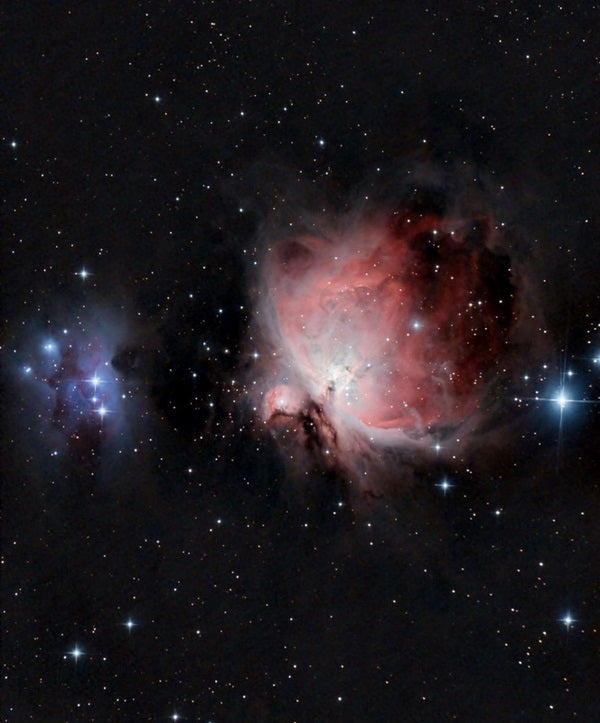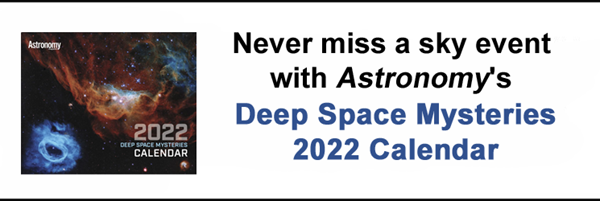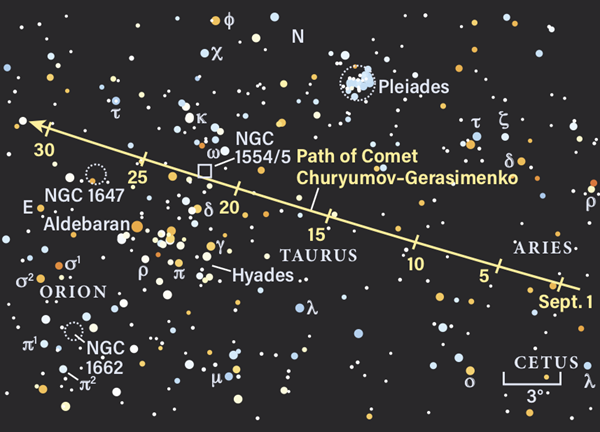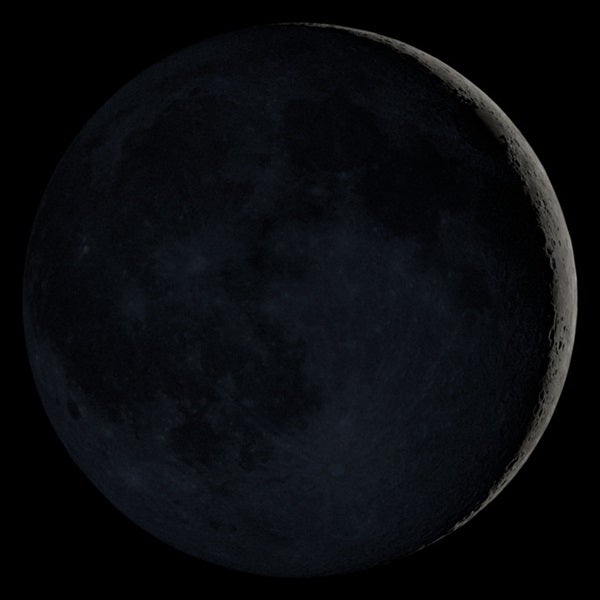Friday, September 3
The giant planets Jupiter and Saturn hover above the southern horizon after dark tonight. Both are in the constellation Capricornus the Sea Goat, with Sagittarius to the west and Aquarius to the east.
Jupiter is the brighter planet at magnitude –2.9, and sits just northeast of magnitude 2.8 Deneb Algedi. Its four largest moons, called the Galilean moons, are busy this week. Tonight, Io will disappear behind the planet’s western limb around 10:30 P.M. EDT. It won’t reappear until 1:11 A.M. EDT on the 4th (check your time zone if your farther west), when it slips out of the planet’s shadow, which extends far east of the disk. But Io is not alone — it’s followed by Europa, which disappears shortly after 11:42 P.M. EDT. The icy moon won’t escape the planet’s shadow until about 3:23 A.M. EDT.
Magnitude 0.3 Saturn sits 17° west of Jupiter, in a region of the constellation devoid of brighter stars. Its spectacular ring system, which stretches 42″ across, is worth a nice, long look. You may also see several of the planet’s moons scattered around it. The brightest, magnitude 8.5 Titan, is about 1′ north of Saturn tonight. Several additional smaller, dimmer moons cluster closer to the rings.
Sunrise: 6:30 A.M.
Sunset: 7:28 P.M.
Moonrise: 2:32 A.M.
Moonset: 6:00 P.M.
Moon Phase: Waning crescent (12%)
*Times for sunrise, sunset, moonrise, and moonset are given in local time from 40° N 90° W. The Moon’s illumination is given at 12 P.M. local time from the same location.
Saturday, September 4
Getting up early on the weekend isn’t always fun, but it can be worth it: This month, the hours before sunrise are when Orion the Hunter is climbing above the horizon, with one of the northern sky’s best sights tucked into his belt. Hanging below the three familiar stars of Orion’s Belt is the soft glow of his sword, formed by the famous Orion Nebula (M42). Although its light can be seen with the naked eye, the nebula itself was not truly discovered until the early 1600s, when several people independently turned telescopes its way.
The nebula spans more than a full degree and is roughly magnitude 4. Binoculars and telescopes both will draw out some of its features, with larger apertures providing ever-more-intricate detail. Nestled within the nebula’s glowing gas are numerous forming stars, some of the oldest of which are the blazingly bright stars of the Trapezium cluster, whose energetic photons are still shaping the nebula today. At least four of these stars are visible under good conditions, but a 6-inch or larger scope should bring out six stellar younglings.
Sunrise: 6:31 A.M.
Sunset: 7:26 P.M.
Moonrise: 3:36 A.M.
Moonset: 6:38 P.M.
Moon Phase: Waning crescent (6%)
Sunday, September 5
Venus passes 1.7° north of Spica at 2 A.M. EDT; however, both are below the horizon at the time. Instead, you can catch them just after sunset. Venus is still 11° high 30 minutes after the Sun disappears, and is now about 1.5° northeast of Spica, whose bright magnitude 1 glow should pop out quickly against the darkening sky. Venus, at magnitude –4, far outshines the star. And if you’re quick, you may also catch fainter, magnitude 0.1 Mercury as well. It’s just 3° above the horizon 30 minutes after sunset and about 15° east of Venus.
But this isn’t the only planetary show tonight. Observers will also want to swing a telescope back toward Jupiter, where — by 30 minutes after sunset in the Midwest, at 8:54 P.M. EDT — Europa and its shadow are transiting the disk, with Ganymede poised just off Jupiter’s eastern limb. By 8:59 P.M. EDT, the large moon has also slipped onto the planet’s face, sharing it with Europa for a mere minute until the latter ends its transit at 9:00 P.M. EDT.
Keep watching, and you’ll see Ganymede’s large shadow cross onto the jovian cloud tops at 10:45 P.M. EDT, while the moon itself is only halfway across the disk. The pair will progress from east to west, with Ganymede’s transit ending just after 12:30 A.M. EDT on the 6th (late on the 5th for the rest of the U.S.) and its shadow disappearing a little less than two hours later.
Sunrise: 6:32 A.M.
Sunset: 7:25 P.M.
Moonrise: 4:42 A.M.
Moonset: 7:12 P.M.
Moon Phase: Waning crescent (2%)
Monday, September 6
New Moon occurs at 8:52 P.M. EDT. With the promise of a dark, moonless sky, it’s the perfect night to search for our solar system’s most distant planet, Neptune, which will reach opposition in about a week. That means it’s visible all night long and well placed for observation.
Neptune currently sits about 2.7 billion miles (4.3 billion kilometers) from Earth. At that vast distance, even its large size (nearly 4 times that of Earth) is reduced to a 2″-wide disk that glows a soft magnitude 7.7. But that’s visible through binoculars, bringing the ice giant within reach of most observers. If you do have a telescope, you may be able to discern its blue-green color, which differentiates it from nearby field stars.
To find Neptune, look for 4th-magnitude Phi (ϕ) Aquarii, which is south-southwest of the Circlet in Pisces. From Phi, scan 4.5° east to locate Neptune, which sits within a triangle of 6th-magnitude field stars (HIP 116266, HIP 116106, and HIP 115953) roughly 6.5° due south of the Circlet.
Sunrise: 6:33 A.M.
Sunset: 7:23 P.M.
Moonrise: 5:52 A.M.
Moonset: 7:41 P.M.
Moon Phase: New
Tuesday, September 7
This week’s dark, moonless skies mean it’s time to enjoy some of the solar system’s fainter sights, including Comet 67P/Churyumov-Gerasimenko, whose dim, 13th-magnitude glow requires a 10-inch scope or more. The rubber duck-shaped comet is currently speeding through western Taurus and is high in the sky early this morning in the hours before sunrise. This is one of the few comets that has been visited with a spacecraft — seven years ago last month, the European Space Agency’s Rosetta mission arrived at 67P, studying the comet in great detail for two years.
You’ll find 67P 6° due north of Omicron (ο) Tauri and 10.5° southwest of the stunning Pleiades star cluster (M45), which in itself is an easy and rewarding target for those with binoculars or small telescopes. This group of young stars is roughly 100 million years old and visible to the naked eye as a tiny dipper-shaped pattern some 14° northwest of bright Aldebaran, the eye of the Bull. Keen-eyed observers or experienced astrophotographers may be able to bring out some of the nebulosity surrounding these stars. Although researchers previously thought this was material left over from the cluster’s formation, we now know it’s actually a local dust cloud the Pleiades are passing through and has nothing to do with the stars themselves. They’re simply lighting the material up as they fly through it.
For those who prefer late-night observing, 67P will rise late tonight just before 10:30 P.M. and can be observed overnight.
Sunrise: 6:34 A.M.
Sunset: 7:22 P.M.
Moonrise: 7:01 A.M.
Moonset: 8:08 P.M.
Moon Phase: Waxing crescent (1%)
Wednesday, September 8
The Moon passes 7° north of Mercury at 4 P.M. EDT. By 20 minutes after sunset, our 5-percent-lit satellite is 5° north-northeast of the planet, which itself hangs just 5° above the western horizon in Virgo. If you can catch the innermost planet with a telescope before it sets, you’ll see that it’s 6″ in diameter and 65 percent lit.
Focus in on the Moon with your scope to enjoy the sight of sunrise over the lunar east. With such a small portion of Luna lit, features close to the eastern limb (which is west in our sky) will stand out in stark contrast, particularly where the terminator — the line that divides light and dark — lies. You may also be able to spot the unlit portion of the Moon glowing faintly with earthshine, which is reflected sunlight bouncing off Earth’s surface.
Sunrise: 6:34 A.M.
Sunset: 7:20 P.M.
Moonrise: 8:12 A.M.
Moonset: 8:35 P.M.
Moon Phase: Waxing crescent (4%)
Thursday, September 9
Moving eastward across the sky, the Moon passes 4° north of Venus at 10 P.M. EDT. Both will have set by that time, but shortly after sunset they’re nearly as close, hanging together in eastern Virgo. The Moon is now three days past New and 11 percent lit, while Venus has brightened slightly to magnitude –4.1. With a telescope, you can see that Venus is 70 percent lit and spans 16″.
As Venus and the Moon sink in the west, look higher above the horizon to find the large constellation Ophiuchus the Serpent-bearer. The 11th-largest constellation in the sky, this region is rich in deep-sky objects that make great targets with so little moonlight to interfere. Numerous star clusters and nebulae are scattered throughout the figure, but the only spiral galaxy worth pointing your telescope to is NGC 6384. Try finding it tonight by dropping 5.5° due south of Rasalhague, the constellation’s magnitude 2 alpha star. Alternatively, NGC 6384 is located just 3.7° northwest of magnitude 2.8 Cebalrai (Beta [β] Ophiuchi). This stunning spiral glows at magnitude 10.4, so it’ll need a larger scope (8 inches or so) to really enjoy much detail. It spans 6.2′ by 4.1′, with a roughly oval or rectangular shape.
Sunrise: 6:35 A.M.
Sunset: 7:18 P.M.
Moonrise: 9:23 A.M.
Moonset: 9:03 P.M.
Moon Phase: Waxing crescent (9%)
Friday, September 10
Asteroid (2) Pallas reaches opposition at 10 P.M. EDT in the constellation Pisces. Visible all night at roughly 9th magnitude, large binoculars or a small telescope will show the main-belt world, which is the third-largest asteroid and contains some 7 percent of the total mass in the main belt. Pallas is currently 4° southwest of magnitude 3.7 Gamma (γ) Piscium, a yellow-orange giant star as bright as 61 Suns. Strangely, this star is moving rapidly relative to the rest of the stars in the Sun’s vicinity — it’s speeding through the sky at some 90 miles (145 km) per second, and will eventually move enough to noticeably stretch the familiar shape of this constellation.
Sunrise: 6:36 A.M.
Sunset: 7:17 P.M.
Moonrise: 10:36 A.M.
Moonset: 9:33 P.M.
Moon Phase: Waxing crescent (17%)













